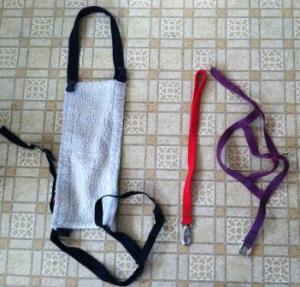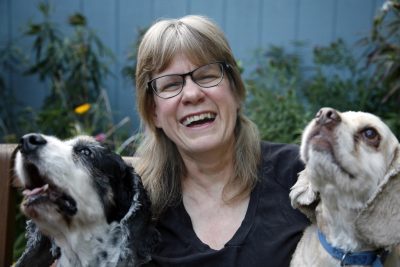
What the ….” I stopped my bicycle in the middle of the forest preserve trail as my three-year-old springer spaniel tried to run alongside. She pumped her back legs hard, but moved in slow motion, her back end not able to keep up with her front legs. I got off my bike and called her to me. Her rear end wobbled as she approached. Crap, she must have hurt her back, but she doesn’t seem to be in pain as she barked at me to continue. Her voice sounded softer than normal. I went home and put her in her crate while I left to teach a three-hour class. This was not how I planned to spend Cassie’s third birthday.
When I returned after 9 pm, she could only scoot on her butt, her front legs dragging her along. I thumbed through several of my veterinary books as my husband, Mitch, who is a research associate at a medical school, read the Dog Owner’s Home Veterinary Handbook by Carlson and Giffin http://books.google.com/books/about/Dog_owner_s_home_veterinary_handbook.html?id=sqJ_bdyceXsC. He diagnosed her paralysis as one of several things: Myasthenia gravis, Coon Hound paralysis, Tick paralysis, or Botulism. I woke several times during the night to make sure she was still breathing as I tossed and turned, wondering if I should take her to the emergency vet. By morning, she couldn’t use any of her four legs. How did this happen to my award winning agility dog?
At 7:30 a.m., Dr. Barcus at the Canine Center http://www.caninecentervet.com/ sent me to a neurologist at Blue Pearl Emergency Veterinary http://bluepearlvet.com/illinois/overview/northfield-il/ and by 9 a.m., the vet told me the exact diagnosis as Mitch had almost twelve hours before. They ran tests and concluded Cassie had Coon Hound paralysis, http://www.petwave.com/Dogs/Health/CoonhoundParalysis/Diagnosis.aspx -even though a raccoon hadn’t bitten her (it’s an autoimmune disease sometimes associated with raccoon saliva). I often wondered if the large number of dogs at her last agility trial exposed her to a bacterial or viral infection causing the disease. Coon Hound paralysis is very similar to Guillain-Barre syndrome (GBS) in people.
Cassie spent the next five days at Blue Pearl, which allowed us to visit her twice a day. She remained paralyzed but alert during treatment, which mostly consisted of observation to make sure she didn’t suffer respiratory distress. She remained paralyzed when I brought her home, but expected to recover in a few days.
Luckily, I still had a sling from my last dog (see photo), a harness, and a short leash that I used for agility training. With these tools, I was able to walk Cassie, like a puppeteer, while she was paralyzed so that she could eliminate properly. Within a day, she could support some of her weight, and within two days, she was walking.
Cassie made a full recovery, although Dr. Barcus noticed a slight weakness in one of her back legs. She warned me to keep her exposure to other dogs limited and to avoid dog agility competitions, groomers, dog parks, and pet stores. If the disease re-occurred within a year, her symptoms could be much worse. After a few months, Cassie braved private agility lessons since she enjoyed it so much, but when the trainer’s dogs became sick with canine influenza, we stopped going. Unfortunately, her bout with Coon Hound paralysis ended Cassie’s agility career, but she continued to have a full life as my constant companion.

